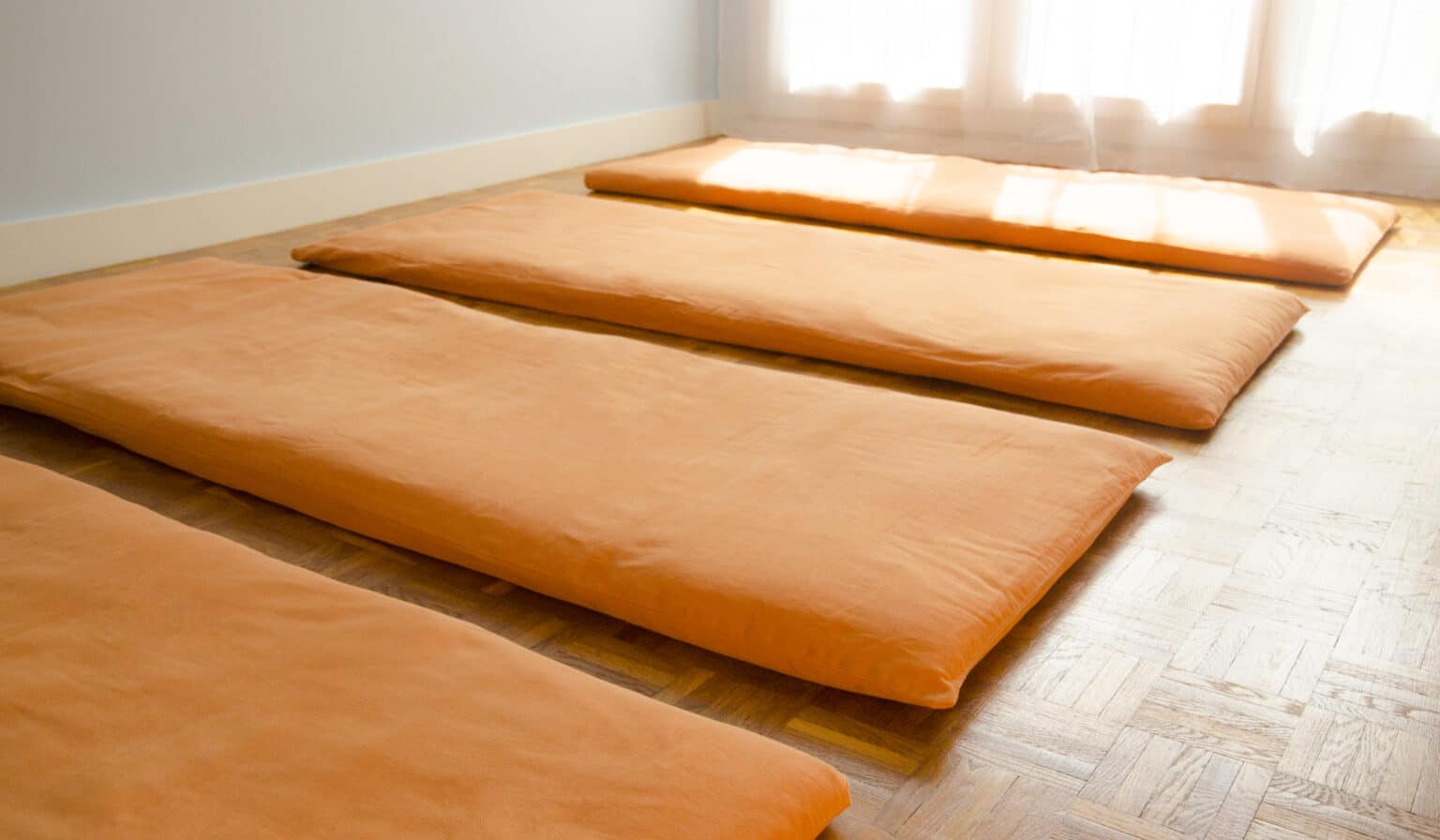Futon yoga mats are excellent for yoga that focus on static yoga poses, pranayama and meditation. In contrast, the common TPE, rubber and PVC mats are suitable for dynamic body-oriented yoga styles. Unless that is what you are into, they are not necessarily the best option. This post will clarify everything you need to know about futon mats for yoga. You will learn why you should consider getting one if you are into slow and conscious yoga.
What is a futon?
A futon is a traditional Japanese bed mattress. Today you can find this type of mattress worldwide. People use thick futons to sleep on and thinner ones as massage mats and for their yoga practice. Since futons are made from cotton, they feel pleasantly natural in contrast to most modern yoga mats. They are also very durable. Correctly taken care of, I have seen many futon mats last more than twenty years despite daily use.
I use a futon mat when I do yoga, and I find it to be by far the best option. In all the yoga centres where I have taught, we have had futons as well. The quality, benefits and comfort of these mats usually impress our yoga students.
What practices are futon yoga mats good for?
Futon mats are perfect for static asana
If your yoga practice is geared towards static poses, you want a mat that is thick enough to sustain you. Otherwise, staying in poses for several minutes gets uncomfortable. A futon is perfect for seated or lying down poses. It is also excellent for inversions such as headstand, the clown pose or shoulder stand.
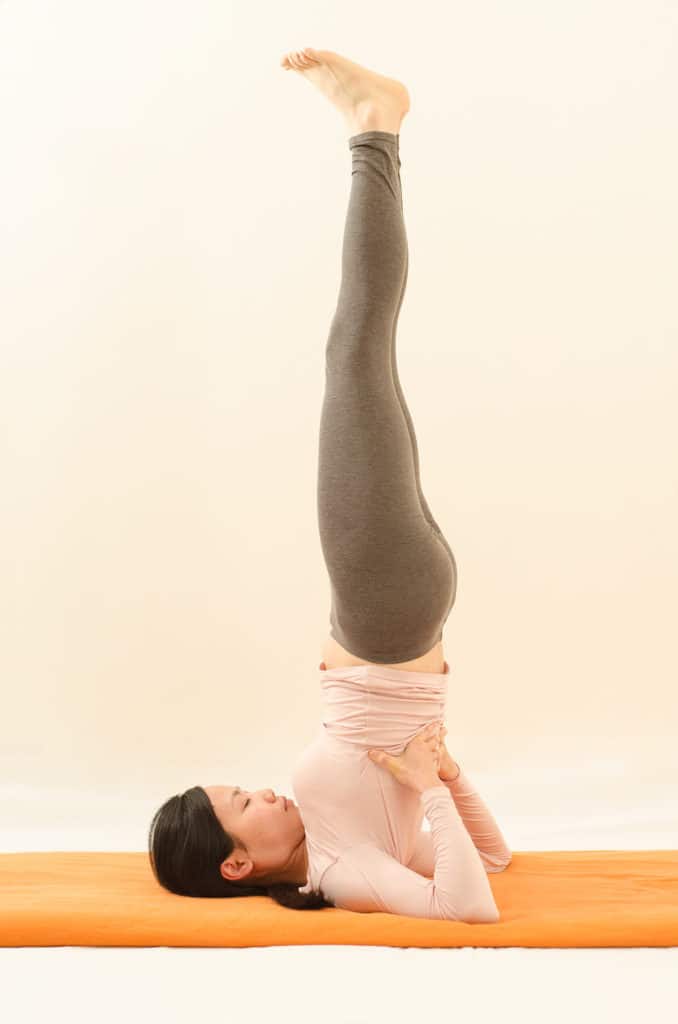
First choice for pawanamuktasana
The pawanamuktasana series is a series of easy movements that come from the Satyananda yoga tradition. You do most of these dynamic exercises sitting flat on the ground. Hence, for such a practice, a futon yoga mat is your best choice.
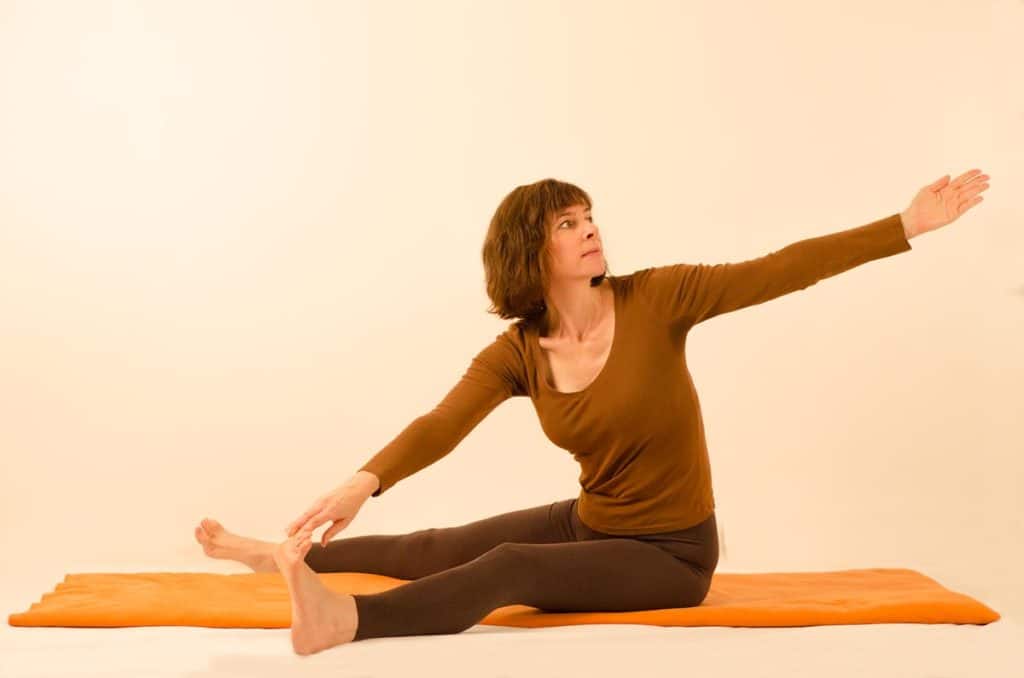
Excellent for meditation poses
Futon yoga mats are also excellent for meditation. If meditation and pranayama are significant elements of your practice, this type of mat is going to suit you. The mat is soft enough to allow for good blood circulation in your legs when used as a meditation support. In addition, you can roll up one of the ends to make an adjustable sitting cushion. Therefore, you don’t need to get a separate meditation cushion.
A fitness yoga mat is too thin to sit on for more than a short while. Rolling it to make a meditation cushion is also not great since it will be way too hard.
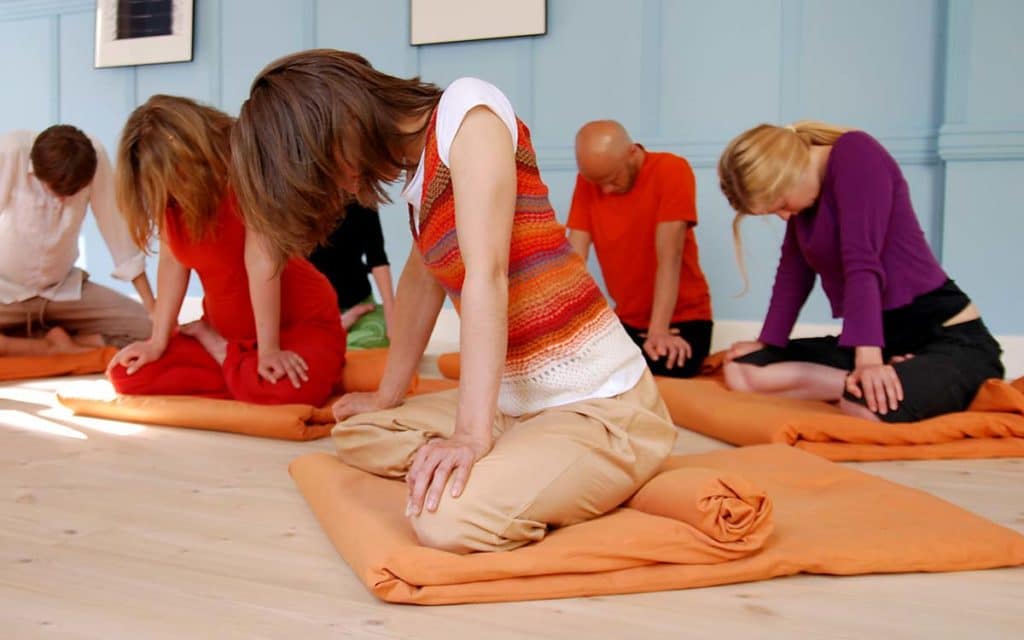
Perfect for yoga nidra
Other practices that are particularly good to do on futon mats are yoga nidra and techniques that require you to lie down. On a futon yoga mat, you will be able to stay comfortable for close to one hour. On a thin fitness mat, you might start feeling sore after as little as ten minutes. So, if long yoga nidras are a part of your routine, you will certainly appreciate the advantages of these mats.
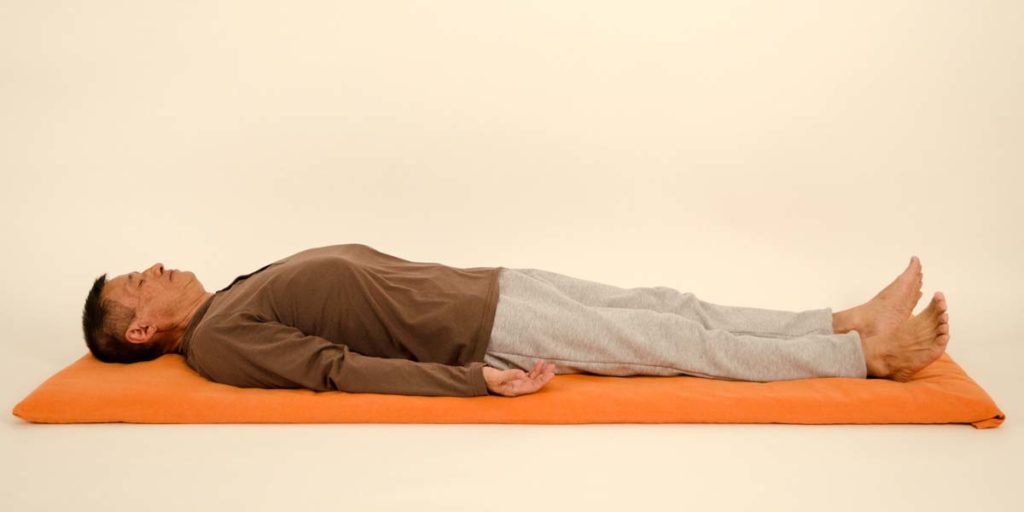
Yoga styles that futons are good for
Practitioners of Satyananda yoga, Sivananda yoga, Yin yoga and other calm yoga styles will love futon mats. They are also great for pregnant women and senior citizens practising yoga.
The yoga I guide here on Forceful Tranquility is based on the Satyananda Yoga tradition. In my sessions, I make heavy use of static poses, pranayama, meditation and shavasana. Hence, if you practice with my online guidance, one of these mats would be your best choice.
Practices that don’t work well with futon mats
If your yoga style is mostly about standing up dynamic practices, then a futon won’t be as necessary. Balance poses, for example, can be a bit trickier on a futon because the extra thickness makes them less stable. The same goes for doing the sun salute. With its constantly changing postures, it requires a thinner stabler surface. At the same time, practising on a less stable surface could be an advantage if you want to add some degree of difficulty to your practice.
Another reason not to use a futon is if your yoga makes you sweat a lot. Since these mats are made of cotton, they are not as easy to clean as ordinary yoga mats. However, if you want a futon anyway, it can help to put a towel on top of the mat to absorb your sweat.
Because of the disadvantages of standing dynamic practices, one yoga centre I know provides both futons and ordinary fitness mats for their students. When the students enter the yoga room, they find futons placed on top of the fitness mats. Whenever needed, the students can remove to practice directly on the thin mat.
I hardly ever feel the need to replace my futon mat. On those rare occasions, I practice standing poses directly on the floor instead.
Dimensions and weight
Futon yoga mats tend to be slightly larger than ordinary mats. You also need to pay attention to the weight when choosing one in addition to size. The weight tells you how much cotton filling there is in the mat and thus how thick it is. I think a weight of 3,75 kg to 4 kg per m2 is ideal. Some producers make their mats a lot thinner. You can find them as thin as 2kg per m2.
If your mat is too thick, you will find it too unstable for inversions and balance poses. A thick mat will also be difficult and clumsy to roll up for meditation.
Depending on the fabrication method, your mat may be very loose and fluffy when delivered. That is why locking at weight is better than thickness. My first futon mat was surprisingly fluffy when it arrived. It took many days of practice before it got flat and compact.
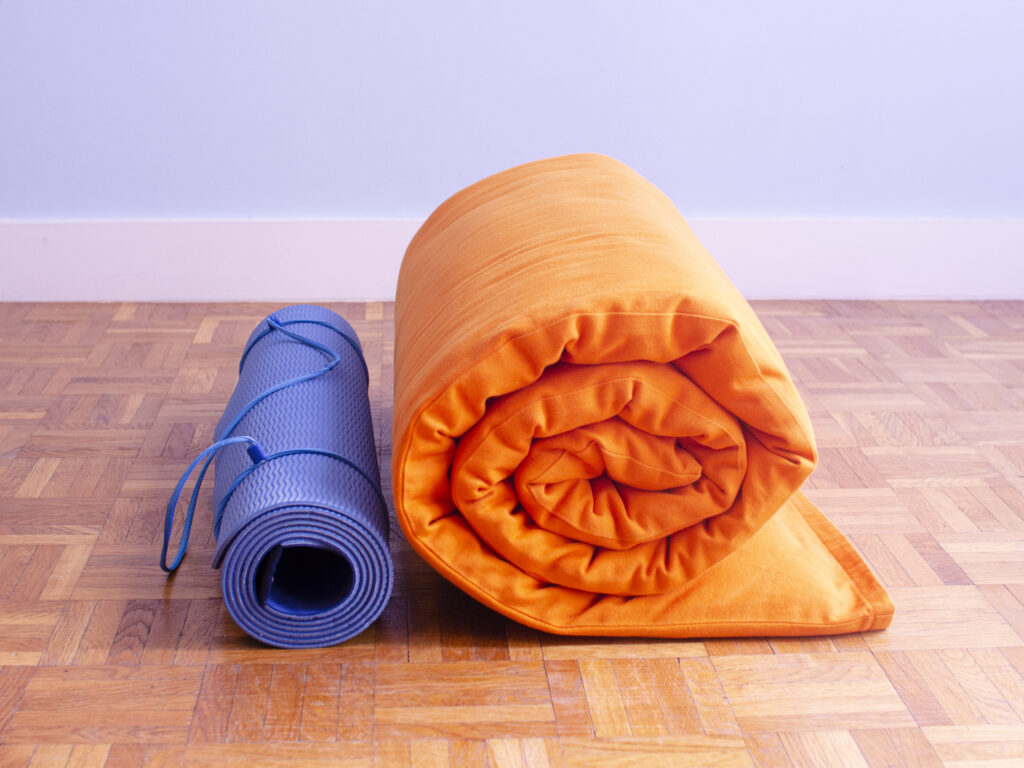
A washable cover is essential
If you want to buy a futon yoga mat, make sure to get one with a removable and washable cover. Since you can’t easily clean the mat itself, a cover is crucial. I prefer mat covers in denim. They feel good and are durable.
Tip!
Cotton covers are easy to sew yourself if you have just a little bit of experience with a sewing machine.
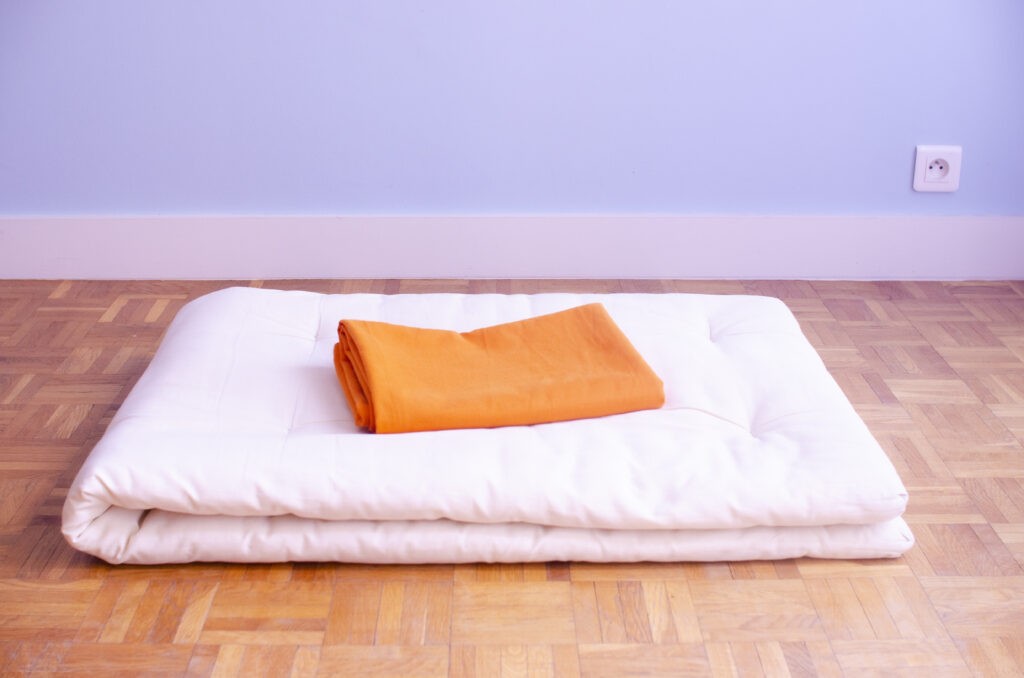
Disadvantages of futon yoga mats
I have already mentioned that futon mats are not the optimal choice if you are into a dynamic yoga style with a strong focus on physical training. But there are other disadvantages to consider as well: They are heavy and bulky.
You might find it too heavy to bring a five-kilo yoga mat to class if you are on foot, bike or motorcycle. In addition, even when you roll it up, a futon mat is big and difficult to carry unless you have a suitable bag.

Futon yoga mats are best when you practice in the same place every time, and you don’t have to move them. Thinner futon mats (2kg/m2) are as transportable as ordinary yoga mats. However, they don’t give you the same benefits as their thicker cousins.
How much does a futon yoga mat cost?
A futon mat will cost you much more than a modern fitness yoga mat. A 185cm x 70cm at 4,8kg will cost you between 80€ and 120€ with an additional 30€ for a cover. Thinner mattresses will cost less, and thicker will cost more. Getting a futon mat for yoga is however an investment that will last. Considering how much you will be able to practice yoga on it, I think it is worthwhile.
Where to buy a futon yoga mat?
Futon yoga mats are far less common than ordinary modern fitness mats. However, with some research, you should find online shops shipping to your location. In addition, many futon shops offer mats for yoga. If they don’t, you can usually make a special order. If you are ordering many pieces, another option is to order directly from a futon factory.
Are you a producer selling futon yoga mats online? I would be happy to test your product and recommend it to my readers if I like it. Get in touch at christian@forceful-tranquility.com
Key Takeaways
- Futon yoga mats are great for calm yoga that focuses on static poses, pranayama and meditation. Futon mattresses are also excellent for yoga nidra and other practices you do in shavasana. If you are only into dynamic modern yoga, getting one isn’t as necessary.
- To benefit from all the advantages, a futon mat for yoga should ideally weigh 3,75 kg to 4 kg per m2.
- A futon mat is expensive, but it can last for decades if you take good care of it.
